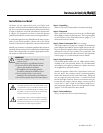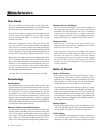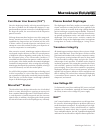
8 Room Acoustics
This is one of those areas that requires both a little back-
ground to understand and some time and experimentation
to obtain the best performance from your system.
Your room is actually a component and an important part
of your system. This component is a very large variable
and can dramatically add to, or subtract from, a great
musical experience.
All sound is composed of waves. Each note has its own
wave size, with the lower bass notes literally encompassing
from 10 feet to as much as 40 feet. Your room participates
in this wave experience like a three-dimensional pool with
waves reflecting and becoming enhanced depending on
the size of the room and the types of surfaces in the room.
Remember, your audio system can literally generate all of
the information required to recreate a musical event in
time, space and tonal balance. The purpose of your room,
ideally, is to not contribute to that information. However,
every room does contribute to the sound, and the better
speaker manufacturers have designed their systems to
accommodate this phenomenon.
Let’s talk about a few important terms before we begin.
Terminology
Standing Waves
The parallel walls in your room will reinforce certain notes
to the point that they will sound louder than the rest of the
audio spectrum and cause “one-note bass”, “boomy bass”
or “tubby bass”. For instance, 100Hz represents a 10 foot
wavelength. Your room will reinforce that specific fre-
quency if one of the dominant dimensions is 10 feet. Large
objects in the room such as cabinetry or furniture can help to
minimize this potential problem. Some serious “audiophiles”
will literally build a special room with no parallel walls just
to help eliminate this phenomenon.
Reflective Surfaces (near-field reflections)
The hard surfaces of your room, particularly if close to your
speaker system, will reflect some waves back into the room
over and over again, confusing the clarity and imaging of
your system. The smaller sound waves are mostly affected
here, and occur in the mid and high frequencies. This is
where voice and frequencies as high as the cymbals occur.
Resonant Surfaces and Objects
All of the surfaces and objects in your room are subject to
the frequencies generated by your system. Much like an
instrument, they will vibrate and “carry on” in syncopation
with the music, and contribute in a negative way to the
music. Ringing, boominess, and even brightness can occur
simply because they are “singing along” with your music.
Resonant Cavities
Small alcoves or closet type areas in your room can be
chambers that create their own “standing waves” and can
drum their own “one-note” sounds.
Clap your hands. Can you hear an instant echo respond
back? You have near-field reflections. Stomp your foot on
the floor. Can you hear a “boom”? You have standing
waves or large panel resonances such as a poorly support-
ed wall. Put your head in a small cavity area and talk
loudly. Can you hear a booming? You’ve just experienced
a cavity resonance.
Rules of Thumb
Hard vs. Soft Surfaces
If the front or back wall of your listening room is soft, it
might benefit you to have a hard or reflective wall in
opposition. The ceiling and floor should follow the same
basic guideline as well. However, the side walls should be
roughly the same in order to deliver a focused image.
This rule suggests that a little reflection is good. As a matter
of fact, some rooms can be so “over damped” with carpeting,
drapes and sound absorbers that the music system can
sound dull and lifeless. On the other hand, rooms can be
so hard that the system can sound like a gymnasium with
too much reflection and brightness. The point is that balance
is the optimum environment.
Breakup Objects
Objects with complex shapes, such as bookshelves, cabi-
netry and multiple-shaped walls can help break up those
sonic gremlins and diffuse any dominant frequencies.
Solid Coupling
Your loudspeaker system generates frequency vibrations or
waves into the room. This is how it creates sound. These
vibrations vary from 20 per second to 20,000 per second.
ROOM ACOUSTICS
Your Room


















